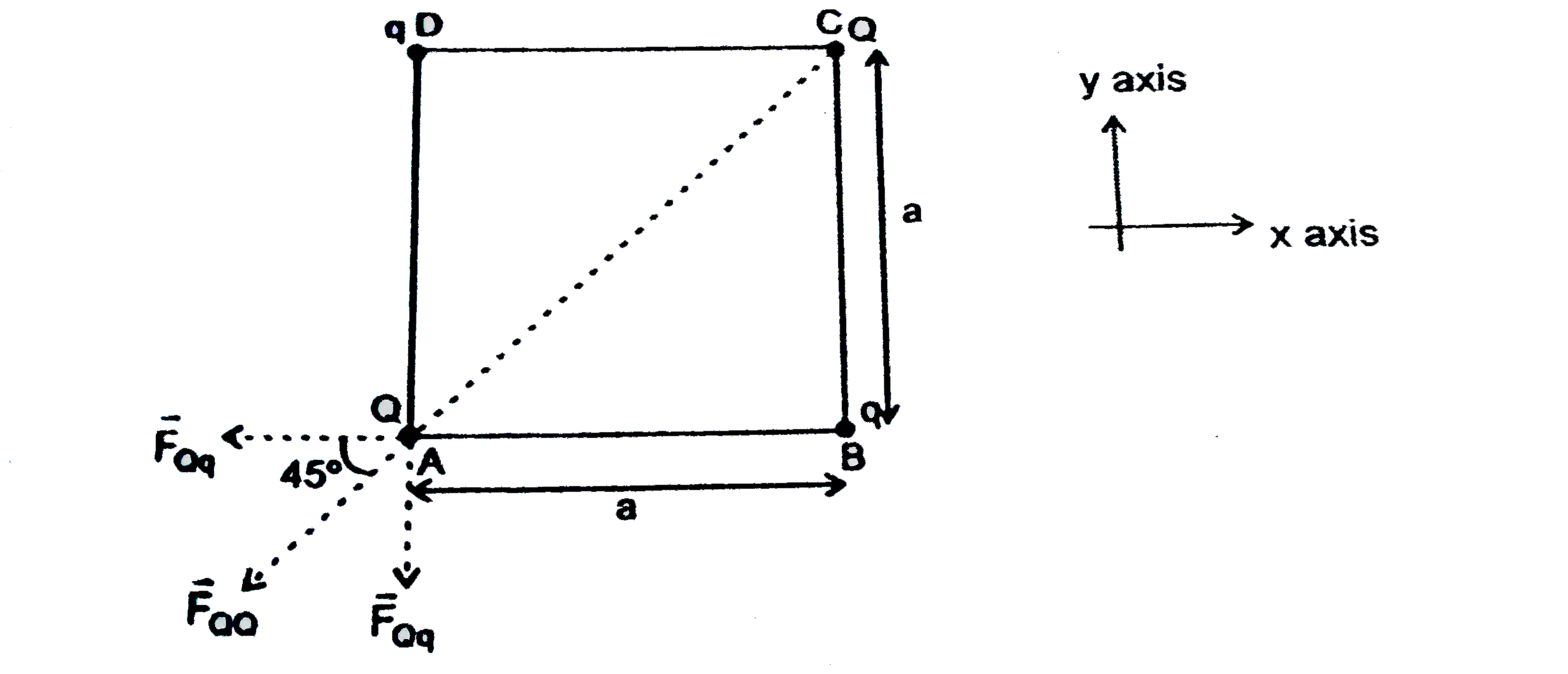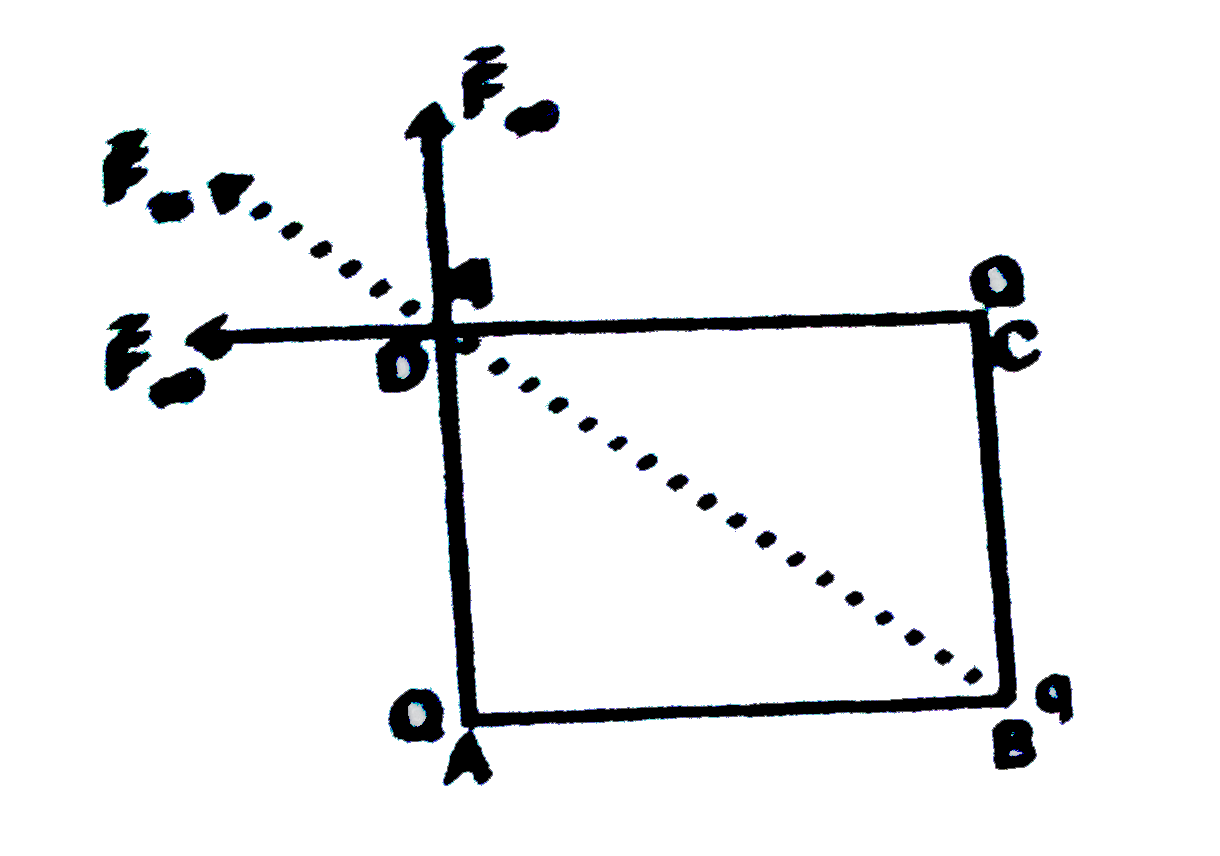A charges Q is placed at each of the two opposite corners of a square. A charge q is placed to each of the other two corners. If the resultant force on each charge q is zero, then
(a) Let on a square ABCD, charges are placed as shown

Now, forces on charge Q (at point A) due to other charge are →FQQ,→DQq and →FQq respectively as shown in figure.
Fnet on Q=→FQ.Q+→FQq+→FQq (at point A)
But Fnet=0
So, ΣFx=0
ΣFx=−FQQcos45∘−FQq
⇒KQ2(√2a)2.1√2+KQqa2=0⇒ q=−Q2√2
(b) For resultant force on each charge o be zero :
From previous data, force on charge Q is zero when q=−Q2√2 If for this value of charge q, force on q is zero, then and only then the value of q exists for which the resultant force on each charge is zero.
Force on q :
Forces on charge q (at point D) due to other three charges are →FqQ,→Fqq and →FqQ respectively as shown in figure.
Net force on charge q :
−→net=→Fqq+→FqQ+→FqQ But →Fnet=0
So, ΣFx=0
ΣFx=−Kq2(√2a)2.1√2−KQq(a)2 ⇒ q=2√2−Q
But from previous condition, q=−Q2√2
So, no value of q makes the resultant force on each charge zero.

Topper's Solved these Questions
- ELECTROSTATICSBOOK - RESONANCE ENGLISHCHAPTER - ELECTROSTATICSEXERCISE - Exercise-1 Section (A)
9 Videos
- ELECTROSTATICSBOOK - RESONANCE ENGLISHCHAPTER - ELECTROSTATICSEXERCISE - Exercise-1 Section (B)
12 Videos
- ELECTROSTATICSBOOK - RESONANCE ENGLISHCHAPTER - ELECTROSTATICSEXERCISE - HLP
40 Videos
- ELECTROMAGNETIC INDUCTIONBOOK - RESONANCE ENGLISHCHAPTER - ELECTROMAGNETIC INDUCTIONEXERCISE - A.l.P
19 Videos
- EXPERIMENTAL PHYSICSBOOK - RESONANCE ENGLISHCHAPTER - EXPERIMENTAL PHYSICSEXERCISE - PART -II
10 Videos
Similar Questions
A charge Q is place at each of the opposite corners of a square. A charge q is placed at each of the other two corners. If the net electrical force on Q is zero, then Q/q equals:
View SolutionTwo equal point charges Q=+√2μC are placed at each of the two opposite corners of a square and equal point charges q at each of the other two corners. What must be the value of q so that the resultant force on Q is zero?
View SolutionFour positive charges (2√2−1)Q are arranged at the four corners of a square. Another charge q is placed at the centre of the square. Resulting force acting on each corner charge is zero if q is
View SolutionA point charge Q is placed at the corner of a square of side a. Find the flux through the square.
View SolutionThree charges each of value q are placed at the corners of an equilateral triangle. A fourth charge Q is placed at the center of the triangle.
a. Find the net force on charge q.
b. If Q=−q, will the charges at the corners move toward the center or fly away from it ?
c. For what value of Q at O will the charges remain stationary ?
d. In situation (c), how much work is done in removing the charges to infinity?
View SolutionFour charges of +q, +q +q and +q are placed at the corners A, B, C and D of s square. The resultant force on the charge at D
View SolutionA charge Q is placed at each corner of a cube of side a. The potential at the centre of the cube is
View SolutionA charge Q is placed at the corner of a cube of edge length L. The electric flux linked to one of the faces not touching the charge Q is
View SolutionFour charges equal to −Q are placed at the four corners of a square and a charge q is at its centre. If the system is in equilibrium the value of q is
View SolutionTwo equal charges q are placed at a distance of 2a and a third charge −2q is placed at the midpoint. The potential energy of the system is
View Solution
